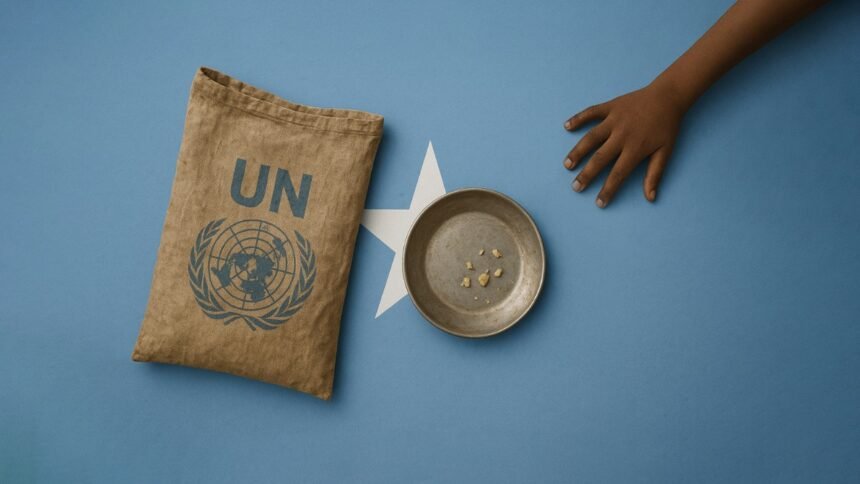In the dusty camps outside Baidoa, mothers queue under a punishing sun, clutching ration cards that no longer guarantee food. The familiar white sacks marked with blue UN logos have grown scarce. Where once trucks arrived weekly, now they come sporadically, if at all. The World Food Programme’s (WFP) recent announcement to cut aid from 1.1 million to just 350,000 people due to funding shortfalls is not just a bureaucratic adjustment — it’s a sentence for millions teetering on the edge of survival.
Somalia has been here before — drought, hunger, conflict, aid dependency — but this time feels different. The country has endured five consecutive failed rainy seasons, and while this year brought modest showers, they were too little, too late. Crops withered, livestock perished, and the soil, long stripped of nutrients, remains hostile to recovery. Humanitarian workers describe a grim arithmetic: more need, less funding, higher costs. “We’re cutting assistance not because the crisis is over, but because the money has dried up,” said a WFP official in Mogadishu, his voice weary with resignation.
The cuts come at a perilous moment. Somalia is still fighting the insurgent group Al-Shabab, whose control over swathes of rural territory complicates aid delivery. Inflation has pushed food prices up by nearly 30 percent since 2023, and the Somali shilling’s decline makes imports even more expensive. For families already surviving on one meal a day, the loss of food assistance means choosing who eats and who waits. “Yesterday, it was my turn to eat. Today, it’s my daughter’s,” whispered Amina, a mother of five in a camp near Kismayo, clutching a bowl of maize flour as if it were treasure.
The international community, fatigued by multiple global crises — Ukraine, Gaza, Sudan, and climate disasters from the Caribbean to the Pacific — has quietly reallocated funds elsewhere. Donor conferences for Somalia attract fewer pledges each year. Western governments cite “limited fiscal space” and “strategic prioritisation.” The euphemisms sound polite enough, but in Baidoa and Beledweyne, they translate to empty stomachs. “It’s donor fatigue, plain and simple,” said an aid worker with an international NGO. “Somalia no longer trends on social media, so it no longer trends in budgets.”
The irony is painful: Somalia’s humanitarian needs are vast, but its political progress has been modestly encouraging. The government in Mogadishu, under President Hassan Sheikh Mohamud, has made strides in stabilising key regions and reforming local governance. Yet these gains are fragile — hunger, after all, is the most efficient destabiliser. The government has pleaded with donors to reconsider, warning that famine could undo years of counterterrorism and reconstruction efforts. But with global attention splintered, Somalia’s cries compete in a noisy world that seems increasingly desensitised to suffering.
Food insecurity also has a gendered face. Women and girls bear the heaviest burden in crisis zones, often eating last and least. Child marriage rates spike during hunger periods as families seek to reduce mouths to feed. Clinics report rising malnutrition among children under five, with some areas recording levels approaching famine thresholds. “We don’t call it famine yet because we’re not ready to admit it,” confided a UN field officer. “But it’s famine in slow motion — you can feel it in every village.”
Adding to the despair is climate volatility. Somalia’s future is shackled to weather patterns it cannot control. The Horn of Africa has become a testing ground for climate resilience — or the lack of it. Flash floods now follow droughts, washing away topsoil and contaminating scarce water sources. The cycle has become tragically predictable: drought kills crops, flood kills hope. “Climate change is the war we never declared,” a Somali environmental activist lamented. “And we’re losing it without weapons.”
Still, amid the desolation, there are glimmers of resistance. Local farmers, backed by small NGOs, are experimenting with drought-resistant seeds and solar-powered irrigation. Community groups run feeding centres independent of foreign aid, funded by the Somali diaspora. “We can’t wait for the world to remember us,” said a young volunteer in Hargeisa. “If help doesn’t come, we’ll feed each other.” His words capture a shift — a grassroots determination born from fatigue with dependency.
Yet there’s only so much self-reliance can achieve when millions face hunger. The UN estimates that without renewed funding, half of Somalia’s population — about eight million people — will face acute food insecurity by early 2026. That number dwarfs the country’s capacity to cope. Aid agencies are pleading not for generosity, but for survival funds. “Somalia is on the brink,” the WFP warned in its latest update. “And when it falls, the cost of picking it back up will be ten times higher.”
In Baidoa’s fading evening light, Amina watches her children sleep, their thin frames wrapped in torn blankets. “I don’t need the world to feed us forever,” she murmurs softly. “Just help us live long enough to feed ourselves.” Her plea, simple yet profound, echoes across a country caught between resilience and ruin — a nation waiting not for miracles, but for mercy that has grown perilously scarce.










